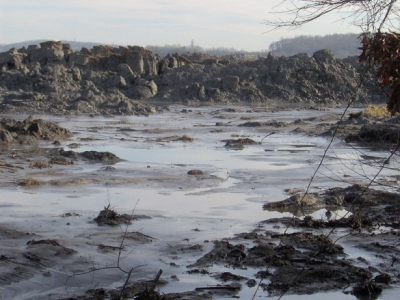On December 22nd, 2008, a quiet evening in the town of Harriman, Tennessee was interrupted when 1.2 billion gallons of toxic coal ash sludge burst out of a nearby landfill, poisoning the land and water in its path and causing untold hardship for families whose lives were turned upside down. A year later, the underlying cause of this massive environmental disaster is still unregulated.
Despite some rumblings and tentative first steps, the EPA has a long way to go before adopting rules that require safer storage of this dangerous muck. At the very least, the agency should move quickly to ban the slurry from being kept in unlined ponds where, even without a spill, it threatens public health by seeping carcinogens into the water supply.
Clean up of the spill is still ongoing—the Tennessee Valley Authority, the entity responsible for the plant in Kingston, says it’s likely to take another two or three years and at least $933 million total to finish the job. Add that to the health costs of contaminated water and respiratory issues of having this stuff around, and the benefits of regulations far outweigh the price electricity companies would pay to comply.
Last year’s spill was a consequence of TVA’s underinvestment in adequate protection. What began as a dike designed to keep about 5 feet of coal ash from flowing into the nearby creek eventually had to contain a mountain of gelatinous waste that was a notable feature of the area’s landscape. With no regulation requiring it, only nominal improvements were made to keep the slurry in place and nothing was done to keep the toxins out of the drinking water.
This kind of behavior is just another way society hides the expensive consequences of burning dirty fuel. “Cheap” energy prices too often comes at the expense of hazards foisted onto unsuspecting neighbors. The families of Harriman experienced the true cost of cheap coal the hard way.
There is much more work to be done to uncover all the health risks associated with unlined coal ash ponds and to conduct a complete cost-benefit analysis of regulating these sites. But most of the missing information is on the benefit side of the equation, so further research is likely to strengthen the economic case for EPA to step in.
Hopefully many years will pass without another spill, but as the head of TVA has recently acknowledged, plants will need to change their storage practices to truly prevent another disaster like Kingston. It’s unclear that we can rely on these facilities to learn from TVA’s mistakes and protect their neighbors from harm without strong rules requiring adequate protection. The EPA should regulate quickly knowing that doing so will yield far more benefits than costs.


